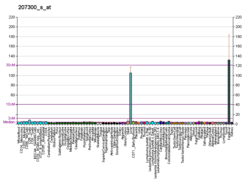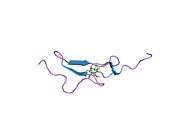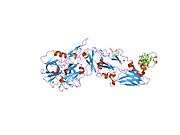Factor VII
Factor VII (EC 3.4.21.21, blood-coagulation factor VIIa, activated blood coagulation factor VII, formerly known as proconvertin) is one of the proteins that causes blood to clot in the coagulation cascade. It is an enzyme of the serine protease class. A recombinant form of human factor VIIa (eptacog alfa [activated], NovoSeven) has U.S. Food and Drug Administration approval for uncontrolled bleeding in hemophilia patients. It is sometimes used unlicensed in severe uncontrollable bleeding, although there have been safety concerns. A biosimilar form of recombinant activated factor VII (AryoSeven) is also available, but does not play any considerable role in the market.
Physiology
The main role of factor VII (FVII) is to initiate the process of coagulation in conjunction with tissue factor (TF/factor III). Tissue factor is found on the outside of blood vessels - normally not exposed to the bloodstream. Upon vessel injury, tissue factor is exposed to the blood and circulating factor VII. Once bound to TF, FVII is activated to FVIIa by different proteases, among which are thrombin (factor IIa), factor Xa, IXa, XIIa, and the FVIIa-TF complex itself. The complex of factor VIIa with TF catalyzes the conversion of factor IX and factor X into the active proteases, factor IXa and factor Xa, respectively.[3]
The action of the factor is impeded by tissue factor pathway inhibitor (TFPI), which is released almost immediately after initiation of coagulation. Factor VII is vitamin K dependent; it is produced in the liver. Use of warfarin or similar anticoagulants decreases hepatic synthesis of FVII.
Structure
Factor VII shares a common domain architecture with factors IX and X.
Genetics
The gene for factor VII is located on chromosome 13 (13q34).
Role in disease
Factor VII deficiency (congenital proconvertin deficiency) is rare and inherited recessively. It presents as a hemophilia-like bleeding disorder. It is treated with recombinant factor VIIa (NovoSeven or AryoSeven).
Medical uses
Recombinant factor VIIa, marketed under the trade names AryoSeven and NovoSeven, is used for people with hemophilia (with Factor VIII or IX deficiency) who have developed antibodies against replacement coagulation factor.
It has also been used in the setting of uncontrollable hemorrhage,[4][5] but its role in this setting is controversial with insufficient evidence to support its use outside of clinical trials.[6] The first report of its use in hemorrhage was in an Israeli soldier with uncontrollable bleeding in 1999.[7] Risks of its use include an increase in arterial thrombosis.[6]
Recombinant human factor VII while initially looking promising in intracerebral hemorrhage failed to show benefit following further study and this is no longer recommended.[8][9]
Interactions
Factor VII has been shown to interact with tissue factor.Also reacts with protein kinase C.[10][11]
References
- ↑ "Human PubMed Reference:".
- ↑ "Mouse PubMed Reference:".
- ↑ Wajima T, Isbister GK, Duffull SB (September 2009). "A comprehensive model for the humoral coagulation network in humans". Clinical Pharmacology and Therapeutics. 86 (3): 290–8. PMID 19516255. doi:10.1038/clpt.2009.87.
- ↑ Roberts HR, Monroe DM, White GC (December 2004). "The use of recombinant factor VIIa in the treatment of bleeding disorders". Blood. 104 (13): 3858–64. PMID 15328151. doi:10.1182/blood-2004-06-2223.
- ↑ Uncontrolled Bleeding and Injury Lawsuit Claims
- 1 2 Simpson E, Lin Y, Stanworth S, Birchall J, Doree C, Hyde C (March 2012). "Recombinant factor VIIa for the prevention and treatment of bleeding in patients without haemophilia". The Cochrane Database of Systematic Reviews. 3 (3): CD005011. PMID 22419303. doi:10.1002/14651858.CD005011.pub4.
- ↑ Kenet G, Walden R, Eldad A, Martinowitz U (November 1999). "Treatment of traumatic bleeding with recombinant factor VIIa". Lancet. 354 (9193): 1879. PMID 10584732. doi:10.1016/S0140-6736(99)05155-7.
- ↑ Mayer SA, Brun NC, Begtrup K, Broderick J, Davis S, Diringer MN, Skolnick BE, Steiner T (February 2005). "Recombinant activated factor VII for acute intracerebral hemorrhage". The New England Journal of Medicine. 352 (8): 777–85. PMID 15728810. doi:10.1056/NEJMoa042991.
- ↑ Mayer SA, Brun NC, Begtrup K, Broderick J, Davis S, Diringer MN, Skolnick BE, Steiner T (May 2008). "Efficacy and safety of recombinant activated factor VII for acute intracerebral hemorrhage". The New England Journal of Medicine. 358 (20): 2127–37. PMID 18480205. doi:10.1056/NEJMoa0707534.
- ↑ Carlsson K, Freskgård PO, Persson E, Carlsson U, Svensson M (June 2003). "Probing the interface between factor Xa and tissue factor in the quaternary complex tissue factor-factor VIIa-factor Xa-tissue factor pathway inhibitor". European Journal of Biochemistry. 270 (12): 2576–82. PMID 12787023. doi:10.1046/j.1432-1033.2003.03625.x.
- ↑ Zhang E, St Charles R, Tulinsky A (February 1999). "Structure of extracellular tissue factor complexed with factor VIIa inhibited with a BPTI mutant". Journal of Molecular Biology. 285 (5): 2089–104. PMID 9925787. doi:10.1006/jmbi.1998.2452.
Further reading
- Broze GJ, Majerus PW (February 1980). "Purification and properties of human coagulation factor VII". The Journal of Biological Chemistry. 255 (4): 1242–7. PMID 7354023.
- Versteeg HH, Peppelenbosch MP, Spek CA (December 2001). "The pleiotropic effects of tissue factor: a possible role for factor VIIa-induced intracellular signalling?". Thrombosis and Haemostasis. 86 (6): 1353–9. PMID 11776298.
- Golino P (May 2002). "The inhibitors of the tissue factor:factor VII pathway". Thrombosis Research. 106 (3): V257–65. PMID 12356487. doi:10.1016/S0049-3848(02)00079-8.
External links
- Official website
- The MEROPS online database for peptidases and their inhibitors: S01.215
- CHES - Comprehensive Health Education Services LLC - Factor VII treatment and awareness







































